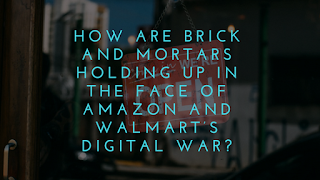How are Brick and Mortars Holding Up in the Face of Amazon and Walmart’s Digital War?
Amazon, once holding a monopoly over the online marketplace, is now slowly losing business in 2017 to a large gamut of companies following in their footsteps. These companies now offer most of their products online, as well as in stores, for people to have more options. What’s more is that brick and mortar stores can, at times, run out of products shoppers wish to obtain.
One such company that is particularly making a name for itself is Walmart. Business Insider noted that Walmart now seems to be Amazon’s number one competitor. In the battle for stealing business from Amazon, Google and Walmart have partnered up. Walmart has a patent in for a floating distribution center. And, online buyers are taking notice, helping Walmart to be neck-in-neck with Amazon in the stock market.
To take it to the next level, Walmart acquired Jet.com, exploding their reach and revenue. This massive move has helped Walmart increase the number of products shipped by 69% in the first half of this year alone. This significant increase has earned Walmart $117.5 billion and increase 2.9% in the stock market.
Because of this all out war between product-sales companies, it may be tempting to predict that in-store purchases will eventually phase out. This couldn’t be further from the truth, however. While Walmart funnels massive amounts of energy into online shopping experiences, so too are they building up their brick and mortars.
This new wave of purchasing options speaks to the the growth of both the online and offline marketplaces.
In-Store vs. Online: How Do Consumers Choose?
Business.com shares sheds light on some fascinating insights from, “consumer psychologist Phillip Graves.” Graves, “explains in The Chicago Tribune [that] consumers are likely to buy familiar, branded items with qualities they can reasonably predict online.” If consumers feel they cannot accurately rely on the images and videos of a good online, describing the nature of the product, they will pivot from digital purchasing to in-store purchasing. This shift is due to the greater hassle they would incur if they received the shipped package, opened it, and did not like it. This would require them to repackage and ship the item back. If they could bypass this annoyance in-store, studies say, they will.
Shopping online is clearly a trend that will stay for the foreseeable future. But, marketers who assume technology will take over the majority of marketplace experiences is ill informed. Shopping is more than just a way to acquire goods for consumers. It is the luxurious experience of searching through quality products that entices customers. These people may go with loved ones to “get away from the world” for a short time. A perfect example of this is when people purchase clothing. Clothing sizes change from store to store even though most use the standard “XS, S, M, L, XL,” model. Because of this, many consumers hesitate to purchase clothing online. For other products such as food containers, cleaning equipment, and bulk products for company-use, the internet is desirable.
As the online marketplace grows, so too will physical store fronts. What ways do you prefer to spend money on goods? Tweet me at @FerhanPatel to continue the conversation!

